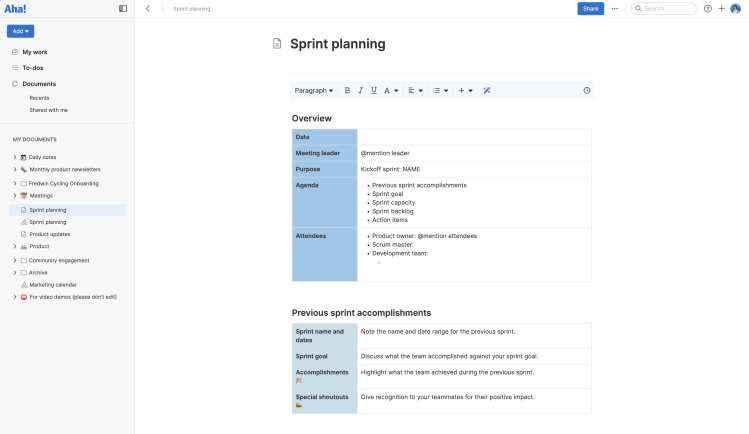Sprint planning meeting template
Outline goals and the work you will complete in your next sprint
Use template
About the sprint planning meeting template
In a sprint planning meeting, scrum teams gather to discuss what needs to be accomplished in the upcoming sprint and how you will tackle the work. Together, the product owner, scrum master, and development team have an opportunity to prioritize tasks and rally around sprint goals.
Use this planning template to decide what you will build, test, and release to customers in the next two to four weeks. There are sections to align around previous achievements, upcoming goals, and team capacity as well as to review your backlog of work. Generally speaking, your sprint meeting should last one to two hours for every week of a sprint. For instance, if your sprint is two weeks long, your planning meeting should take two to four hours.
Sprint planning meetings are all about finding the perfect mix of strategic alignment and tactical planning. It is not just about assigning tasks — but about bringing the team together to create a shared vision of what the work represents and, importantly, how it will make a difference for customers and the business.
How to use the sprint planning meeting template
Conduct effective sprint planning meetings and address any questions, concerns, or uncertainties.
Set an agenda and goals Establish the purpose of your planning session and who will attend. Identify sprint goals and assign to-dos to the team ahead of time to ensure that everyone comes to the meeting prepared for a productive session.
Refine the product backlog Before the meeting, the product owner should ensure that the backlog is in good shape, with well-defined and prioritized user stories.
Celebrate shared wins As your planning session gets underway, take a moment to recognize what the team achieved in the last sprint. Acknowledging collective effort boosts team morale and motivates everyone to continue pushing forward.
Align on capacity Assess the team's availability for the upcoming sprint by considering factors like planned time off or other commitments. Use this information along with your average sprint velocity to determine the amount of work you can realistically take on.
Plan next steps Assign tasks, @mention the assignee, summarize the status, and track the due date. When everyone is accountable to tasks and deadlines, you can make steady progress together.